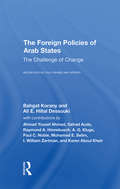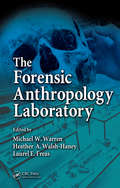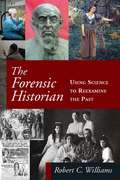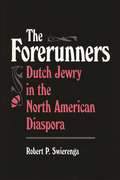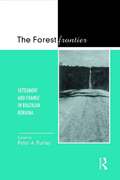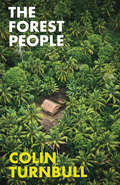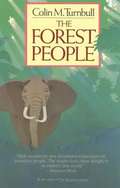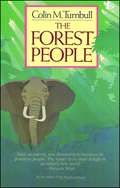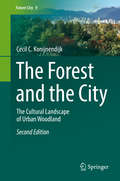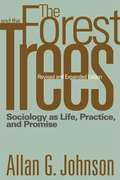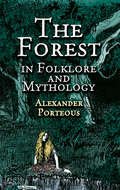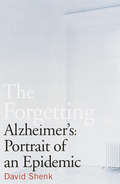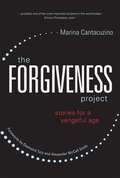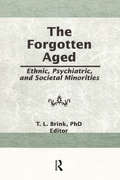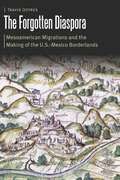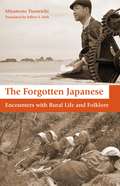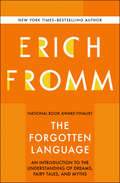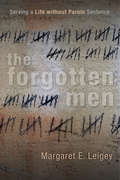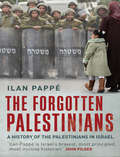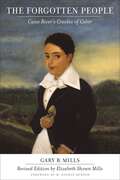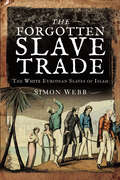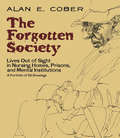- Table View
- List View
The Foreign Policies Of Arab States: The Challenge Of Change
by Bahgat Korany Ali El-Din DessoukiMiddle East politics have been proverbial for their changeability. The 1970s ushered in petro-politics, for instance, but OPEC's international status declined markedly in the following decade. Similarly, the Arab world's ostracism of Egypt in the 1970s following its separate peace with Israel was turned around in the 1980s; the late 1980s also brought PLO acceptance of the State of Israel. Interstate relations were not the only arena to experience significant alterations; state-society relations also underwent dramatic changes, such as the acceleration of privatization in erstwhile socialist regimes. Then the 1990s opened with a political earthquake: the Gulf Crisis. The second edition of this highly acclaimed text offers a penetrating analysis of trends in Arab foreign policies since the book was originally published in 1984, including an early analysis of the effects of Iraq's invasion of Kuwait and the subsequent coalition victory over Iraq. In addition, the authors have included new chapters on Jordan—at the heart of the Arab world—and on the Sudan—the region's link to sub-Saharan Africa. Their inclusion allows a fuller understanding of the foreign policies of states that occupy crucial geopolitical positions but wield little tangible power. Moreover, in many of its chapters the book raises the crucial question of how the foreign policies of these countries can cope with the prevalence of political change.
The Forensic Anthropology Laboratory
by Michael W. Warren Heather A. Walsh-Haney Laurel E. FreasWhile other books cover general topics and various subsets of forensic anthropology, this one-of-a-kind reference compiles the best practices of policies, procedures, and protocols of different laboratories across the world. This book brings together experts in every aspect of forensic anthropology to consider physical plant demands, equipment needs, staffing, ethical issues, and the process of certification with the American Society of Crime Laboratory Directors. With examples of implementation, The Forensic Anthropology Laboratory also provides discussion of proven methods in skeletal preparation, laboratory flow, and specimen curation including processing logs and sample forms.
The Forensic Historian: Using Science to Reexamine the Past
by Robert C WilliamsModern forensic science has significantly affected historical debate over some well-known past crimes or mysteries, utilizing modern DNA, nuclear, and chemical analyses to reexamine the past. This book takes an in-depth look at 20 significant cases where investigators have applied new forensic techniques to confirm, dispute, or revise accepted historical accounts. Among the cases included are the murder of King Tut, the validity of the Vinland Map, the authenticity of the Hitler diaries, Joan of Arc's ashes, the bones of Anastasia, arsenic and the death of Napoleon, and the dating of the Shroud of Turin, plus 13 more.
The Forerunners: Dutch Jewry in the North American Diaspora (American Jewish Civilization Series)
by Robert P. SwierengaBetween 1800 and 1880 approximately 6500 Dutch Jews immigrated to the United States to join the hundreds who had come during the colonial era. Although they numbered less than one-tenth of all Dutch immigrants and were a mere fraction of all Jews in America, the Dutch Jews helped build American Jewry and did so with a nationalistic flair. Like the other Dutch immigrant group, the Jews demonstrated the salience of national identity and the strong forces of ethnic, religious, and cultural institutions. They immigrated in family migration chains, brought special job skills and religious traditions, and founded at least three ethnic synagogues led by Dutch rabbis. <P><P> The Forerunners offers the first detailed history of the immigration of Dutch Jews to the United States and to the whole American diaspora. Robert Swierenga describes the life of Jews in Holland during the Napoleonic era and examines the factors that caused them to emigrate, first to the major eastern seaboard cities of the United States, then to the frontier cities of the Midwest, and finally to San Francisco. He provides a detailed look at life among the Dutch Jews in Boston, New York, Philadelphia, Baltimore, and New Orleans. This is a significant volume for readers interested in Jewish history, religious history, and comparative studies of religious declension. Immigrant and social historians likewise will be interested in this look at a religious minority group that was forced to change in the American environment.
The Forest Frontier: Settlement and Change in Brazilian Roraima
by Edited by Peter A. FurleyDestructive patterns of Amazonian evolution are now infecting relatively untouched Northern Brazil - driven by the gold rush and demographic and economic forces from the South. The Forest Frontier assesses whether the Northern Amazonian States can avoid the same pressures and problems that affect the peoples and environments of the South. It examines the social and environmental nature of land development in Roraima, the most northerly of the Brazilian Amazonian states. Possessing most of the classic problems facing other States as well as containing a combination of political, cultural and environmental features, Roraima's development is at a frontier. Offering a critical assessment of the nature and pace of agricultural advance into Roraima, The Forest Frontier will provide a better understanding to plan for the inevitable development to come.
The Forest People
by Colin M TurnbullThe Forest People is an astonishingly intimate and life-enhancing account of a hunter-gatherer tribe living in harmony with nature -- and an all-time classic of anthropology.For three years, Colin Turnbull lived with an isolated group of Pygmies deep in the forest of the African Congo, experiencing their daily life first-hand. He attended their hunting parties and initiation ceremonies, witnessed their music and their rituals, observed their quarrels and love affairs. He documented them as an anthropologist but was accepted among them as a friend.A ground-breaking work in its time, The Forest People made him one of the most famous intellectuals of the 1960s and 1970s. It remains a transporting account of an earthly paradise and of a legendary and fascinating people.With a new foreword by Horatio Clare.
The Forest People
by Colin M. TurnbullBook describes the author's experiences while living with the BaMbuti Pygmies, not as a clinical observer, but as their friend, learning their customs and sharing their daily life. Turnbull conveys the lives and feelings of the BaMbuti whose existence centers on their intense love for their forest world, which, in return for their affection and trust, provides their every need.
The Forest People
by Colin TurnbullThe Forest People -- Colin M. Turnbull's best-selling, classic work -- describes the author's experiences while living with the BaMbuti Pygmies, not as a clinical observer, but as their friend learning their customs and sharing their daily life. Turnbull conveys the lives and feelings of the BaMbuti whose existence centers on their intense love for their forest world, which, in return for their affection and trust, provides their every need. We witness their hunting parties and nomadic camps; their love affairs and ancient ceremonies -- the molimo, in which they praise the forest as provider, protector, and deity; the elima, in which the young girls come of age; and the nkumbi circumcision rites, in which the villagers of the surrounding non-Pygmy tribes attempt to impose their culture on the Pygmies, whose forest home they dare not enter. The Forest People eloquently shows us a people who have found in the forest something that makes their life more than just living -- a life that, with all its hardships and problems and tragedies, is a wonderful thing of happiness and joy.
The Forest People
by Colin TurnbullThe bestselling, classic text on one anthropologist's incredible experience living among the African Mbuti Pygmies, and what he learned from their culture, customs, and love of life.In this bestselling book, Colin Turnbull, a British cultural anthropologist, details the incredible Mbuti pygmy people and their love of the forest, and each other. Turnbull lived among the Mbuti people for three years as an observer, not a researcher, so he offers a charming and intimate firsthand account of the people and their culture, and especially the individuals and their personalities. The Forest People is a timeless work of academic and humanitarian significance, sure to delight readers as they take a trip into a foreign culture and learn to appreciate the joys of life through the eyes of the Mbuti people.
The Forest People without a Forest: Development Paradoxes, Belonging and Participation of the Baka in East Cameroon
by Glory M. LueongDevelopment interventions often generate contradictions around questions of who benefits from development and which communities are targeted for intervention. This book examines how the Baka, who live in Eastern Cameroon, assert forms of belonging in order to participate in development interventions, and how community life is shaped and reshaped through these interventions. Often referred to as ‘forest people’, the Baka have witnessed many recent development interventions that include competing and contradictory policies such as ‘civilize’, assimilate and integrate the Baka into ‘full citizenship’, conserve the forest and wildlife resources, and preserve indigenous cultures at the verge of extinction.
The Forest and the City: The Cultural Landscape Of Urban Woodland
by Cecil C. KonijnendijkAmsterdamse Bos, Bois de Boulognes, Epping Forest, Hong Kong’s country parks, Stanley Park: throughout history cities across the world have developed close relationships with nearby woodland areas. In some cases, cities have even developed – and in some cases are promoting – a distinct ‘forest identity’. This book introduces the rich heritage of these city forests as cultural landscapes, and shows that cities and forests can be mutually beneficial.Essential reading for students and researchers interested in urban sustainability and urban forestry, this book also has much wider appeal. For with city forests playing an increasingly important role in local government sustainability programs, it provides an important reference for those involved in urban planning and decision making, public affairs and administration, and even public health. From providers of livelihoods to healthy recreational environments, and from places of inspiration and learning to a source of conflict, the book presents examples of city forests from around the world. These cases clearly illustrate how the social and cultural development of towns and forests has often gone hand in hand. They also reveal how better understanding of city forests as distinct cultural and social phenomena can help to strengthen synergies both between cities and forests, and between urban society and nature.
The Forest and the Trees: Sociology as Life, Practice, and Promise
by Allan G. JohnsonIf sociology could teach everyone just one thing, what would it be? The Forest and the Trees is one sociologist's response to the hypothetical--the core insight with the greatest potential to change how people see the world and themselves in relation to it. This revised and updated edition features: * A new chapter that brings together the various aspects of the sociological model described in previous chapters with a detailed application to the origins of racism in the United States * A discussion of how individuals can participate in social change by stepping off paths of least resistance * The addition of graphics to illustrate the sociological model of systems and individuals
The Forest in Folklore and Mythology
by Alexander PorteousAssembled from an enormous range of sources, this fascinating book is a mind-expanding compendium of facts, folklore, superstitions, myths, and anecdotes about trees and the forest. Included are descriptions of old forests; forest customs, temples and sacred groves; mythical forest creatures such as witches, fairies, demons, wood spirits, the "wild huntsman," and wood nymphs.The author also recounts facts and fables about individual trees, including famous trees throughout the world, unusual trees, tree worship, people's transformation into trees, and disposal of the dead in trees — as well as folklore about fossil trees, tree bark, leaves, thorns, diving rods, and Yule logs.This long-unavailable treasury of legend and lore will be welcomed by naturalists, anthropologists, students of folklore, and general readers alike.
The Forgetting: Alzheimer's: Portrait of an Epidemic
by David ShenkNATIONAL BESTSELLERA powerfully engaging, scrupulously researched, and deeply empathetic narrative of the history of Alzheimer&’s disease, how it affects us, and the search for a cure.Afflicting nearly half of all people over the age of 85, Alzheimer&’s disease kills nearly 100,000 Americans a year as it insidiously robs them of their memory and wreaks havoc on the lives of their loved ones. It was once minimized and misunderstood as forgetfulness in the elderly, but Alzheimer&’s is now at the forefront of many medical and scientific agendas, for as the world&’s population ages, the disease will touch the lives of virtually everyone. David Shenk movingly captures the disease&’s impact on its victims and their families, and he looks back through history, explaining how Alzheimer&’s most likely afflicted such figures as Jonathan Swift, Ralph Waldo Emerson, and Willem de Kooning. The result is a searing and graceful account of Alzheimer&’s disease, offering a sobering, compassionate, and ultimately encouraging portrait.
The Forgiveness Project: Stories for a Vengeful Age
by Alexander Mccall Smith Marina Cantacuzino Archbishop Emeritus Desmond TutuWhat is forgiveness? Are some acts unforgivable? Can forgiveness take the place of revenge? Powerful real-life stories from survivors and perpetrators of crime and violence reveal the true impact of forgiveness on ordinary people worldwide. Exploring forgiveness as an alternative to resentment or retaliation, the storytellers give an honest, moving account of their experiences and what part forgiveness has played in their lives. Despite extreme circumstances, their stories open the door to a society without revenge. All royalties from the sale of this book go to The Forgiveness Project charity.
The Forgotten Aged: Ethnic, Psychiatric, and Societal Minorities
by T.L. BrinkThis helpful book explores mental health issues relating to elders who do not fit into the “usual” mold for research--white, married or widowed, urban or suburban persons with adult children. The Forgotten Aged focuses on those groups of elders often overlooked in gerontological literature--elder African-Americans, rural aged, gay and lesbian aged, parents of developmentally disabled offspring, older developmentally disabled persons themselves, and “orphan” elders (those who do not have close family members who can serve as caretakers). The book offers “how to” advice on issues such as outreach, intervention, residential placement and transition, assessment, psychotherapy, and team building to help readers learn effective ways of helping elderly persons from these various groups. With an optimistic tone, it explores how more attention and resources, combined with flexible modifications of programs and practices, can yield favorable results for everyone involved. In The Forgotten Aged, authors examine a variety of pertinent topics including: assessment of dementia and depression in African-Americans multidisciplinary team outreach to elderly living in rural areas therapeutic issues with gay and lesbian aged residential transitions for developmentally disabled elderly helping aging parents of developmentally disabled offspring intervention with “orphan” elderly with Alzheimer’s diseaseSocial workers, psychologists, psychiatrists, geriatricians, nurses, and counselors involved in providing support and care for elderly persons will find The Forgotten Aged a useful guide in their daily work and decisionmaking. This book can also serve as an enlightening supplementary text in courses that study aging and the elderly.
The Forgotten Diaspora: Mesoamerican Migrations and the Making of the U.S.-Mexico Borderlands (Borderlands and Transcultural Studies)
by Travis JeffresIn The Forgotten Diaspora Travis Jeffres explores how Native Mexicans involved in the conquest of the Greater Southwest pursued hidden agendas, deploying a covert agency that enabled them to reconstruct Indigenous communities and retain key components of their identities even as they were technically allied with and subordinate to Spaniards. Resisting, modifying, and even flatly ignoring Spanish directives, Indigenous Mexicans in diaspora co-created the U.S.-Mexico borderlands and laid enduring claims to the region. Jeffres contends that tens of thousands—perhaps hundreds of thousands—of central Mexican Natives were indispensable to Spanish colonial expansion in the Greater Southwest in the sixteenth and seventeenth centuries. These vital allies populated frontier settlements, assisted in converting local Indians to Christianity, and provided essential labor in the mining industry that drove frontier expansion and catapulted Spain to global hegemony. However, Nahuatl records reveal that Indigenous migrants were no mere auxiliaries to European colonial causes; they also subverted imperial aims and pursued their own agendas, wresting lands, privileges, and even rights to self-rule from the Spanish Crown. Via Nahuatl-language &“hidden transcripts&” of Native allies&’ motivations and agendas, The Forgotten Diaspora reimagines this critical yet neglected component of the hemispheric colonial-era scattering of the Americas&’ Indigenous peoples.
The Forgotten Fifth: African Americans in the Age of Revolution
by Gary NashAs the United States gained independence, a full fifth of the country's population was African American. The experiences of these men and women have been largely ignored in the accounts of the colonies' glorious quest for freedom. In this compact volume, Gary B. Nash reorients our understanding of early America, and reveals the perilous choices of the founding fathers that shaped the nation's future. <p><p> Nash tells of revolutionary fervor arousing a struggle for freedom that spiraled into the largest slave rebellion in American history, as blacks fled servitude to fight for the British, who promised freedom in exchange for military service. The Revolutionary Army never matched the British offer, and most histories of the period have ignored this remarkable story. The conventional wisdom says that abolition was impossible in the fragile new republic. Nash, however, argues that an unusual convergence of factors immediately after the war created a unique opportunity to dismantle slavery. The founding fathers' failure to commit to freedom led to the waning of abolitionism just as it had reached its peak. In the opening decades of the nineteenth century, as Nash demonstrates, their decision enabled the ideology of white supremacy to take root, and with it the beginnings of an irreparable national fissure. The moral failure of the Revolution was paid for in the 1860s with the lives of the 600,000 Americans killed in the Civil War. <p> The Forgotten Fifth is a powerful story of the nation's multiple, and painful, paths to freedom.
The Forgotten Japanese
by Jeffrey Irish Tsuneichi MiyamotoTsuneichi Miyamoto (1907-1981), a leading Japanese folklore scholar and rural advocate, walked 160,000 kilometers to conduct interviews and capture a dying way of life. This collection of photos, vignettes, and life stories from pre- and postwar rural Japan is the first English translation of his modern Japanese classic. From blowfish to landslides, Miyamoto's stories come to life in Jeffrey Irish's fluid translation.
The Forgotten Language: An Introduction to the Understanding of Dreams, Fairy Tales, and Myths
by Erich FrommRenowned psychoanalyst Erich Fromm investigates the universal language of symbols, expressed through dream and myths, and how it illuminates our humanity. In this study, Erich Fromm opens up the world of symbolic language, &“the one foreign language that each of us must learn.&” Understanding symbols, he posits, helps us reach the hidden layers of our individual personalities, as well as connect with our common human experiences. By grasping the symbolic language of dreams, Fromm explains, we can then also understand the deeper wisdom of myths, art, and literature. This also gives us access to what we, and our society, usually repress. Fromm shares the history of dream interpretations, and demonstrates his analysis of many types of dreams. This ebook features an illustrated biography of Erich Fromm including rare images and never-before-seen documents from the author&’s estate.
The Forgotten Men
by Margaret E. LeigeyToday there are approximately fifty thousand prisoners in American prisons serving life without parole, having been found guilty of crimes ranging from murder and rape to burglary, carjacking, and drug offences. In The Forgotten Men, criminologist Margaret E. Leigey provides an insightful account of a group of aging inmates imprisoned for at least twenty years, with virtually no chance of release. These men make up one of the most marginalized segments of the contemporary U.S. prison population. Considered too dangerous for rehabilitation, ignored by prison administrators, and overlooked by courts disinclined to review such sentences, these prisoners grow increasingly cut off from family and the outside world. Drawing on in-depth interviews with twenty-five such prisoners, Leigey gives voice to these extremely marginalized inmates and offers a look at how they struggle to cope. She reveals, for instance, that the men believe that permanent incarceration is as inhumane as capital punishment, calling life without parole "the hard death penalty." Indeed, after serving two decades in prison, some wished that they had received the death penalty instead. Leigey also recounts the ways in which the prisoners attempt to construct meaningful lives inside the bleak environment where they will almost certainly live out their lives. Every state in the union (except Alaska) has the life-without-parole sentencing option, despite its controversial nature and its staggering cost to the taxpayer. The Forgotten Men provides a much-needed analysis of the policies behind life-without-parole sentencing, arguing that such sentences are overused and lead to serious financial and ethical dilemmas.
The Forgotten Palestinians: A History of the Palestinians in Israel
by Ilan PappéFor more than 60 years, hundreds of thousands of Palestinians have lived as Israeli citizens within the borders of the nation formed at the end of the 1948 conflict. Occupying a precarious middle ground between the Jewish citizens of Israel and the dispossessed Palestinians of the West Bank and the Gaza Strip, the Israeli Palestinians have developed an exceedingly complex relationship with the land they call home; however, in the innumerable discussions of the Israel-Palestine problem, their experiences are often overlooked and forgotten. In this book, historian Ilan Pappé examines how Israeli Palestinians have fared under Jewish rule and what their lives tell us about both Israel's attitude toward minorities and Palestinians' attitudes toward the Jewish state. Drawing upon significant archival and interview material, Pappé analyzes the Israeli state's policy towards its Palestinian citizens, finding discrimination in matters of housing, education, and civil rights. Rigorously researched yet highly readable, The Forgotten Palestinians brings a new and much-needed perspective to the Israel-Palestine debate.
The Forgotten People: Cane River's Creoles of Color (Library of Southern Civilization)
by Gary B. Mills Elizabeth Shown Mills H. Sophie BurtonOut of colonial Natchitoches, in northwestern Louisiana, emerged a sophisticated and affluent community founded by a family of freed slaves. Their plantations eventually encompassed 18,000 fertile acres, which they tilled alongside hundreds of their own bondsmen. Furnishings of quality and taste graced their homes, and private tutors educated their children. Cultured, deeply religious, and highly capable, Cane River's Creoles of color enjoyed economic privileges but led politically constricted lives. Like their white neighbors, they publicly supported the Confederacy and suffered the same depredations of war and political and social uncertainties of Reconstruction. Unlike white Creoles, however, they did not recover amid cycles of Redeemer and Jim Crow politics.First published in 1977, The Forgotten People offers a socioeconomic history of this widely publicized but also highly romanticized community -- a minority group that fit no stereotypes, refused all outside labels, and still struggles to explain its identity in a world mystified by Creolism.Now revised and significantly expanded, this time-honored work revisits Cane River's "forgotten people" and incorporates new findings and insight gleaned across thirty-five years of further research. This new edition provides a nuanced portrayal of the lives of Creole slaves and the roles allowed to freed people of color, tackling issues of race, gender, and slave holding by former slaves. The Forgotten People corrects misassumptions about the origin of key properties in the Cane River National Heritage Area and demonstrates how historians reconstruct the lives of the enslaved, the impoverished, and the disenfranchised.
The Forgotten Slave Trade: The White European Slaves of Islam
by Simon Webb“A solid introduction and useful survey of slaving activity by the Muslims of North Africa over the course of several centuries.” —ChroniclesEverybody knows about the transatlantic slave trade, which saw black Africans snatched from their homes, taken across the Atlantic Ocean and then sold into slavery. However, a century before Britain became involved in this terrible business, whole villages and towns in England, Ireland, Italy, Spain and other European countries were being depopulated by slavers, who transported the men, women and children to Africa where they were sold to the highest bidder. This is the forgotten slave trade; one which saw over a million Christians forced into captivity in the Muslim world.Starting with the practice of slavery in the ancient world, Simon Webb traces the history of slavery in Europe, showing that the numbers involved were vast and that the victims were often treated far more cruelly than black slaves in America and the Caribbean. Castration, used very occasionally against black slaves taken across the Atlantic, was routinely carried out on an industrial scale on European boys who were exported to Africa and the Middle East. Most people are aware that the English city of Bristol was a major center for the transatlantic slave trade in the eighteenth century, but hardly anyone knows that 1,000 years earlier it had been an important staging-post for the transfer of English slaves to Africa.Reading this book will forever change how you view the slave trade and show that many commonly held beliefs about this controversial subject are almost wholly inaccurate and mistaken.
The Forgotten Society: A Portfolio of 92 Drawings
by Alan E. Cober Leslie Cober-GentryA prominent artist ventured behind locked doors to portray three "forgotten" social classes. Alan E. Cober encountered his subjects in retirement homes as well as such notorious institutions as Willowbrook State School and Sing Sing Correctional Facility. His 92 expressive portraits of social outsiders recall the traditions of Albrecht Dürer and George Grosz.
